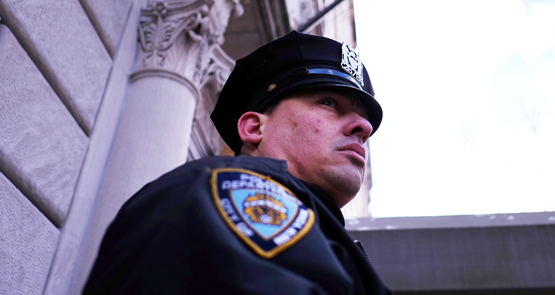In the wake of the Ferguson protests following the shooting of 18-year-old Michael Brown at the hands of a police officer, a number of conservative commentators took the ensuing mistrust of an increasingly militarised police force in the US to mean one thing: police across America were the victims of a brutal war being waged on them by a hostile, radicalised public. But a look at the recent crime figures released by the FBI suggest that, like the War on Christmas, this one might still be in the cold stages.
Are more police being attacked?
In short, no. The FBI’s Law Enforcement Officers Killed and Assaulted (LEOKA) figures on police being assaulted reveal that since 2004 the number of offices attacked on duty has been decreasing.
Of these assaults — described as incidents involving “more than verbal abuse or minor resistance to arrest” — just over one in four resulted in physical injury to the officer, with the vast majority being caused by “personal weapons”: hands, fists or feet. Of the 49,851 officers assaulted in 2013, only 234 were a result of an ambush situation, with the majority resulting from disturbance calls and attempted arrests.
Are more police being killed?
The number of officers actually killed in the line of duty is also in general decline. In contrast to this, though, the Bureau of Justice Statistics’ Homicide Trends in the United States, 1980-2008 report, indicates that the number of “justifiable homicides” — that is, the killing of a felon by an officer — resulting from attacks on officers has been increasing. A joint report by the Treatment Advocacy Centre and the National Sheriffs’ Association looking at these figures found:
“Although the total number of justifiable homicides decreased by 5% between 1980 and 2008, those resulting from an attack on a law enforcement officer increased by 67%, from an average of 153 to 255 such homicides per year.”
Who decides if homicide is “justifiable”?
A “justifiable homicide” is defined in this context as “the killing of a felon by a law enforcement officer in the line of duty” — although just how justifiable these killings were in each particular circumstance is beyond the scope of such statistics. In addition to this, any information on a police shooting is entirely self-reported. The responsibility for reporting such events lies entirely with the 18,000 state and local law enforcement agencies operating in the United States — no reliable national database or taskforce is given the authority to ensure that reports are accurate or, indeed, happen at all.
Muddying the issue more is the fact that what data the FBI does receive only focuses on those shootings of suspected felons that result in death — cold comfort to those seriously injured or crippled in the event of a police shooting. Some reports put the number of people shot and killed by police each year as over 1000 — more than double the 461 reported by the FBI for 2013.
Who’s more likely to be shot?
Echoing a report by the Australian Institute of Criminology looking at police shootings here in Australia — which revealed in 2013 that an estimated 42% of those gunned down by police over the last 22 years were suffering from mental illness — there have been suggestions that as many as half of the victims of justifiable homicide in the US had mental health problems. Until the US government starts looking closer at those lives lost to police shootings, though, the true extent of this violence will remain unclear.








Paul, I trust you don’t assert that the propaganda of various U.S. Middle Class Elites encouraging minorities to interpret whatever undesirable outcome happens to them as ‘unjust’ actions of a ‘Police State’ can be a factor in increasing attacks on police, which is then far more likely to become an increasingly vicious cycle?
Nor does it help when positive discriminations in favour of ‘special’ minorities [which consequently means discrimination against non-favoured sections of society] are seen by the recipients as less than they should have received.
Read the text Norman, attacks on police are decreasing!
Matt Hardin, try to read and UNDERSTAND the point I raised, which is that the number of attacks on police can be affected by what’s being pushed by various influential elites. If you genuinely can’t understand that I can only suggest you consider spending some of your efforts on coming to grips with relevant aspects of basic stats and scientific method.
There must still be some decent standard courses available in Australia, despite the watering down of our ‘university’ standards.
Part of the problem is that the U.S. war machine has been dumping 100’s of millions of dollars worth of excess military equipment onto police departments so that it gets back some government money to buy new stuff and the government can say it is doing something to combat crime and terror. It leads to many situations where provincial police forces of less than 10 officers have armouries with crates of assualt rifles, a couple of grenade launchers and an armoured vehicles with mounted heavy machine guns.
Added to this, many military veterans hardened by counter-insurgency warfare are joining the ranks of police forces without adequate civilian readjustment support (with most other veterans). Some of the larger forces, particularly the LAPD, are actively integrating military counter-insurgency doctrines into their own tactics.
If you only have hammers, everyone is a nail. If you aggressively treat your population like the enemy, don’t be surprised if they start to see themselves and act like one. (As the figures show though, this has only led to protests so far. It’s still much more dangerous to be poor and unarmed than a cop with a gun.)